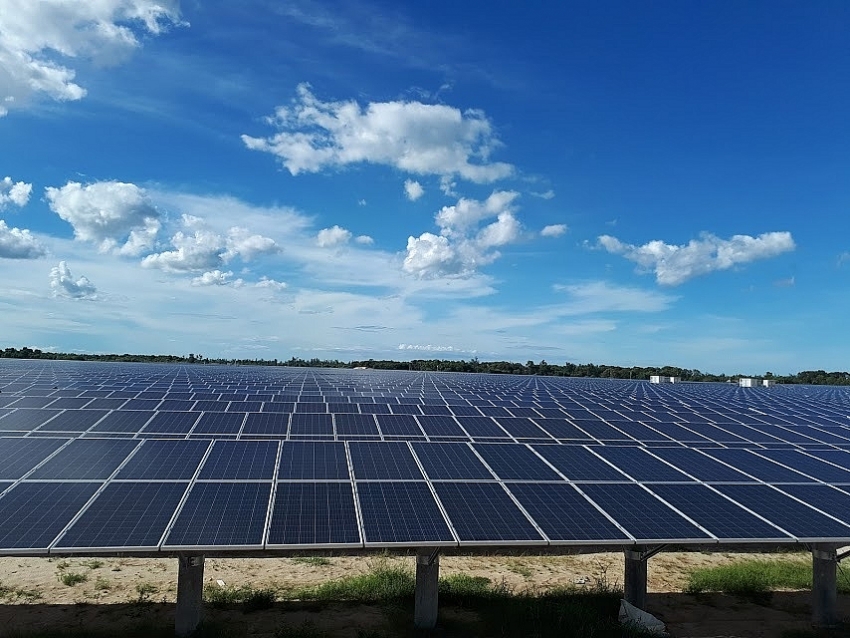New World Bank strategy to help Vietnam scale up solar power
 |
| The World Bank has drawn up a new strategy to help Vietnam scale up and better utilise solar power |
These approaches could boost Vietnam’s solar generation capacity from the current 4.5GW to the tens of GW range within ten years, while creating thousands of new jobs, according to the new World Bank Vietnam Solar Competitive Bidding Strategy and Framework report. The deployment of new solar generation will be a critical factor for the government of Vietnam to meet its Nationally Determined Contribution (NDC) emissions reduction target and reduce its need for new coal generation.
The report comes as Vietnam is considering moving from a feed-in tariff (FiT) policy to a competitive bidding scheme for solar projects to reduce the cost of solar generation. The FIT has been successful in recent years, spurring the fast deployment of projects at a time when Vietnam has also become a world leader in solar module manufacturing. However, this success has also given rise to new issues, including curtailment – or underuse of solar generation capacity.
The report, supported by the Global Infrastructure Facility (GIF) and the World Bank’s Energy Sector Management Assistance Program (ESMAP), recommends two new deployment schemes for projects: competitive bidding for solar parks, and "substation-based bidding" – competitive bidding based on available capacity at electrical substations. These approaches would address the curtailment issue as well as improve risk allocation between public and private investors.
The first pilot tenders – 500MW for substation-based bidding and another 500MW for ground-mounted solar parks – are being planned for later in 2020 with the technical and financial support of the World Bank.
“The World Bank is fully committed to helping Vietnam achieve its sustainable energy ambitions,” said Ousmane Dione, World Bank country director for Vietnam. “We expect that this new strategy will open up a new chapter in Vietnam’s already successful solar power expansion.”
Beyond the new approaches to competitive bidding, the report recommends setting yearly and medium-term solar deployment targets and revisions to the legal framework covering the competitive selection of independent power producers.
The report estimates that the expansion in solar generation capacity in Vietnam could generate as many as 25,000 new jobs in project development, services, and operations and maintenance annually through 2030 and another 20,000 jobs in manufacturing, provided Vietnam maintains its current share of the global solar equipment market.
“We are grateful for the World Bank's support to promote renewable energy in Vietnam,” said Hoang Tien Dung, general director of the Electricity and Renewable Energy Authority under the Ministry of Industry and Trade.
“In particular, the World Bank’s support to the government’s efforts to shift from FiT to a competitive bidding mechanism for solar PV could be applied for other types of renewable energy in the future. It contributes to the sustainable and transparent development of renewable energy in Vietnam by harmonising the interests of private investors, the government and customers.”
The World Bank has been instrumental in supporting the Government of Vietnam’s solar development planning for years. Since 2017, with financing from ESMAP and GIF, the World Bank has provided a large portfolio of technical assistance ranging from solar resource mapping to strategic advice on the mobilisation of private investment in utility-scale solar projects.
What the stars mean:
★ Poor ★ ★ Promising ★★★ Good ★★★★ Very good ★★★★★ Exceptional
Related Contents
Latest News
More News
- TCP Group partner with VNUS to launch water conservation project (December 25, 2025 | 14:00)
- Heavy industries set for pilot greenhouse gas quotas (December 25, 2025 | 10:00)
- Swedfund invests in MSME growth and climate action in Vietnam (December 19, 2025 | 11:42)
- GreenYellow brings solar energy to light up remote schools in Tuyen Quang province (December 19, 2025 | 08:00)
- Charge+, Grab partner to develop EV charging network in Vietnam (December 18, 2025 | 17:11)
- Linking sci-tech and innovation to Vietnam’s net-zero future (December 18, 2025 | 14:31)
- Driving double-digit growth through green and circular transformation in Vietnam (December 17, 2025 | 09:00)
- Standard Chartered and ACCA deepen collaboration to develop Vietnam’s talent for a sustainable future (December 15, 2025 | 18:18)
- Schaeffler reports strong early output from Dong Nai solar project (December 12, 2025 | 15:16)
- Forestry conference highlights biodiversity and sustainability goals (December 09, 2025 | 13:35)

 Tag:
Tag:



























 Mobile Version
Mobile Version